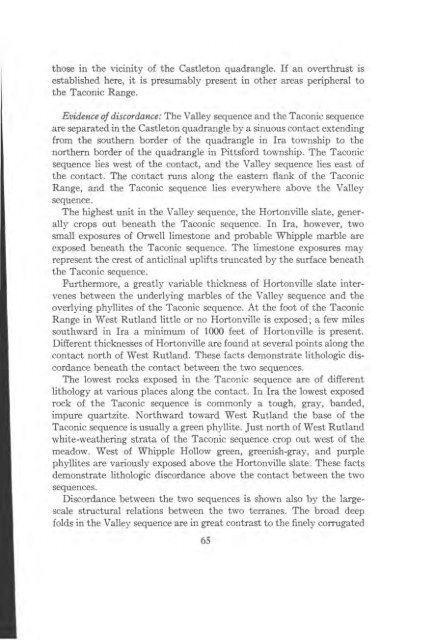STRATIGRAPHY AND STRUCTURE CASTLETON AREA VERMONT
STRATIGRAPHY AND STRUCTURE CASTLETON AREA VERMONT
STRATIGRAPHY AND STRUCTURE CASTLETON AREA VERMONT
You also want an ePaper? Increase the reach of your titles
YUMPU automatically turns print PDFs into web optimized ePapers that Google loves.
those in the vicinity of the Castleton quadrangle. If an overthrust is<br />
established here, it is presumably present in other areas peripheral to<br />
the Taconic Range.<br />
Evidence of discordance: The Valley sequence and the Taconic sequence<br />
are separated in the Castleton quadrangle by a sinuous contact extending<br />
from the southern border of the quadrangle in Ira township to the<br />
northern border of the quadrangle in Pittsford township. The Taconic<br />
sequence lies west of the contact, and the Valley sequence lies east of<br />
the contact. The contact runs along the eastern flank of the Taconic<br />
Range, and the Taconic sequence lies everywhere above the Valley<br />
sequence.<br />
The highest unit in the Valley sequence, the Hortonville slate, generally<br />
crops out beneath the Taconic sequence. In Ira, however, two<br />
small exposures of Orwell limestone and probable Whipple marble are<br />
exposed beneath the Taconic sequence. The limestone exposures may<br />
represent the crest of anticlinal uplifts truncated by the surface beneath<br />
the Taconic sequence.<br />
Furthermore, a greatly variable thickness of Hortonville slate intervenes<br />
between the underlying marbles of the Valley sequence and the<br />
overlying phyllites of the Taconic sequence. At the foot of the Taconic<br />
Range in West Rutland little or no Hortonville is exposed; a few miles<br />
southward in Ira a minimum of 1000 feet of Hortonville is present.<br />
Different thicknesses of Hortonville are found at several points along the<br />
contact north of West Rutland. These facts demonstrate lithologic discordance<br />
beneath the contact between the two sequences.<br />
The lowest rocks exposed in the Taconic sequence are of different<br />
lithology at various places along the contact. In Ira the lowest exposed<br />
rock of the Tacoriic sequence is commonly a tough, gray, banded,<br />
impure quartzite. Northward toward West Rutland the base of the<br />
Taconic sequence is usually a green phyllite. Just north of West Rutland<br />
white-weathering strata of the Taconic sequence crop out west of the<br />
meadow. West of Whipple Hollow green, greenish-gray, and purple<br />
phyllites are variously exposed above the Hortonville slate. These facts<br />
demonstrate lithologic discordance above the contact between the two<br />
sequences.<br />
Discordance between the two sequences is shown also by the largescale<br />
structural relations between the two terranes. The broad deep<br />
folds in the Valley sequence are in great contrast to the finely corrugated<br />
65













